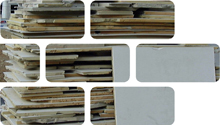
Insulated Plasterboard Composite 17 08 02
Insulated plasterboard (thermal laminated board) is a composite sheet product made from gypsum board backed with mostly foam insulation but can be other types of insulation material. Insulated plasterboard is manufactured in a wide range of styles, sizes, thicknesses and finishes depending on the specification required. It is bound to insulation and may include a vapour barrier foil. Some boards have fire retardant and/or water resistant additives. Excludes gypsum products containing or covered in asbestos containing materials, which should be determined by the site survey. NFDC has worked with WRAP to increase the amount of plasterboard sent for recycling and not to landfill. This DRIDS should be read alongside the HBCD DRIDS.
Usage & Probable Locations
Insulated plasterboard is mostly used for lining walls and ceilings, but are also used for protecting rafters, trusses, steel frames and some door types. Insulated plasterboard can be found in domestic, industrial and commercial buildings. They are also used for pre-fabricated panels and build systems that are manufactured offsite. Insulated plasterboard is located under roofs, on gable ends, internal walls and ceilings.
Personal Protective Equipment
PPE requirements indicated are for guidance purposes only. DRIDS has identified the PPE that is mandatory on all demolition projects and ones that may be required subject to site specific Risk Assessment & Method Statement (RAMS). Hover over the icon to determine the types of PPE required for the removal of this material.
Removal, Segregation & Storage
The plasterboard zero waste to landfill target of 2025 is encouraging the plasterboard supply chain to recover and recycle all plasterboard from demolition and construction. Insulated plasterboard is recognised as a hard-to-treat board that the British Rigid Urethane Foam Manufacturers Association (BRUFMA) and manufacturers are investigating manual or mechanical separating processes for the insulation and board. The option for beneficial reuse of recycled gypsum for agricultural land improvement now requires a permit, as defined in the revised Plasterboard Quality Protocol. Insulated plasterboard destined for recycling should be segregated and stored in designated skips, bins or bulk bags. Non-hazardous insulated plasterboard should only be sent to landfill as a last resort. It should be disposed in a landfill for non-hazardous waste in a cell where no biodegradable waste is accepted. Insulated plasterboard is not permitted in mixed landfill. Refer to PAS109 Quality Protocol.
Tools
Fixtures, Fittings & Connections
Insulated plasterboard has been traditionally fixed in place with plasterboard nails, screws or wall/coving adhesive. For some wall panel systems, the plasterboard sheets will tightly run inside metal, timber or plastic channels without the need for fixings. Thermal laminated boards containing plasterboard, insulation panels and vapour barrier foil are bound together with adhesive and can be difficult to separate for recycling. Where insulated plasterboard is used as a component part in quick-build panel systems, they may incorporate a range of fixtures and fixings including snap-connections, specialist brackets, stud and ferules, tracks, clamps and hinges.
Health & Safety
Subject to task-specific Risk Assessment & Method Statement (RAMS). Use correct protective equipment for removing fixings, especially nails and screws. Wear gloves when handling sheets with damaged edges and containing vapour barrier foil to prevent irritation and cuts. Wear eye protection when removing nails or screws with hand tools, crowbar, hammer or nailbar. Wear eye protection and dust mask to prevent dust inhalation or into eyes.
Further reading
- Plasterboard Sustainability Partnership
- Plasterboard Sustainability Action Plan Report 2013
- Plasterboard PAS 109
- Plasterboard REAP
- Plasterboard Recycling
- Quality Protocol for Gypsum
- Environment Agency Position Statement on Plasterboard
- WRAP Designing out waste Plasterboard
- HSE Safe Handling of Plasterboard














